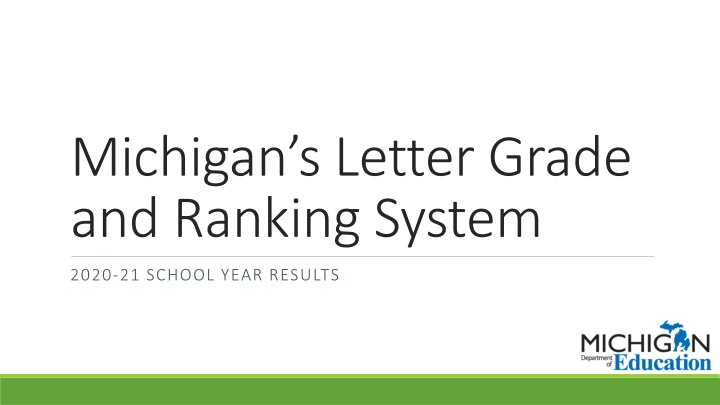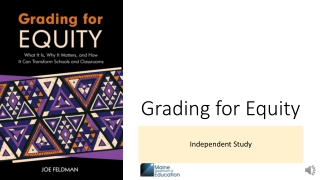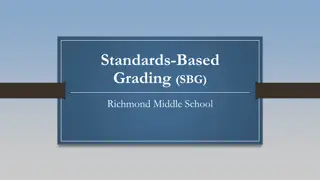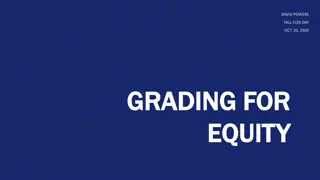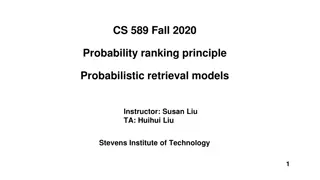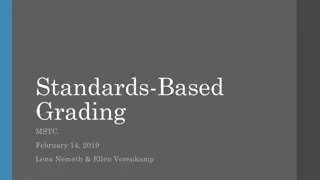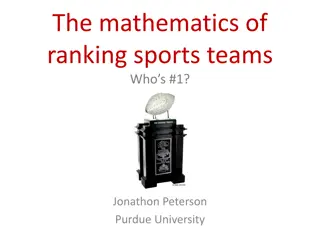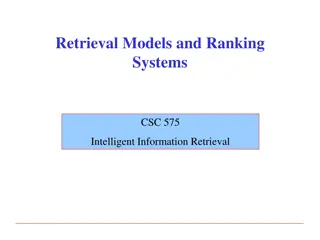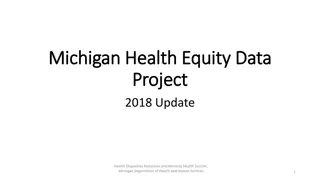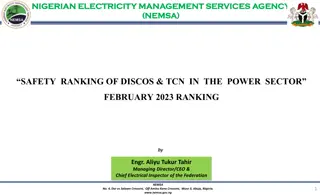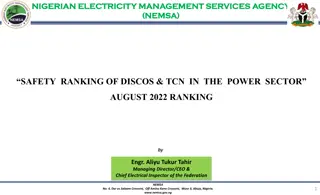Michigan's School Grading and Ranking System 2020-21
Public Act 601 of 2018 mandates annual letter grades and rankings for Michigan's public schools, identifying lowest and highest achieving schools, as well as those with consistently underperforming subgroups. A Peer Review Panel with diverse members reviews findings and submits reports. The design and development focus on simplicity for parents and the general public, using existing policies and aligning with MDE priorities. The involvement of the State Board of Education led to changes in the standard setting process, addressing variables for peer school comparison.
Download Presentation

Please find below an Image/Link to download the presentation.
The content on the website is provided AS IS for your information and personal use only. It may not be sold, licensed, or shared on other websites without obtaining consent from the author.If you encounter any issues during the download, it is possible that the publisher has removed the file from their server.
You are allowed to download the files provided on this website for personal or commercial use, subject to the condition that they are used lawfully. All files are the property of their respective owners.
The content on the website is provided AS IS for your information and personal use only. It may not be sold, licensed, or shared on other websites without obtaining consent from the author.
E N D
Presentation Transcript
Michigans Letter Grade and Ranking System 2020-21 SCHOOL YEAR RESULTS
Public Act 601 of 2018 Requirements Annual letter grades and ranking labels For all public schools No summative grade/ranking Identification of: Lowest achieving schools (State Comprehensive Support and Improvement) Highest achieving schools (Reward) Schools with consistently underperforming subgroups Alternative Education Campuses excluded from letter grades and rankings Means Center Programs are excluded Peer review panel Review and submit findings to Michigan Department of Education (MDE) and state legislature
Peer Review Panel 5 Members: Represent various locations and groups in Michigan 3 Members appointed by the Governor 1 Member appointed by the Senate Majority Leader 1 Member appointed by the Speaker of the House of Representatives Autonomous Submit findings to MDE and standing committees of the senate and house of representatives Panel Actions Met several times to review system materials Final report submitted to MDE and Michigan Legislature October 31, 2019
Design and Development Approaches Simple and understandable for parents and the general public Combined subjects; very little disaggregation Schools will earn up to five letter grades and three ranking labels Reuse of existing policies, practices, and procedures for school and district familiarity Schools, districts, and other consumers of these data will need to comprehend two different accountability systems and sets of results Align as closely as possible to existing MDE priorities and systems
State Board of Education Involvement SBE considered options to initial MDE-designed system Changes to cut scores Participation EL Progress Graduation Rate Proficiency Growth Methodology changes Variables used in peer school comparison
Accountability for Traditional Schools
Letter Grade Indicators Student proficiency Single letter grade based on combined math and ELA performance Students enrolled for a full academic year (FAY) Students adequate growth Single letter grade based on combined math and ELA performance Students enrolled for a full academic year (FAY) English Learner (EL) adequate growth Based on the English language proficiency assessment (WIDA) Based on School Index methodology uses both proficiency and growth on WIDA Graduation rate Using best of the 4-, 5-, or 6-year cohort rate Student proficiency compared to similar schools
Ranking Label Indicators Rate of chronically absent students Ranking labels Significantly Above Average Above Average Average Below Average Significantly Below Average Assessment participation rate Single ranking based on combined math and ELA participation rates Student subgroup proficiency compared with corresponding statewide student subgroup proficiency
Other System Features No summative grade or ranking label Schools receive up to five letter grades and three ranking labels Indicators use aggregated all students population with the following exceptions EL performance comprised only of EL students Student subgroup comparison uses disaggregated student groups Minimum n-size thresholds are aligned with existing accountability system rules Student growth, proficiency, similar schools = 1 EL growth, assessment participation, subgroup comparison = 30 Graduation rate, chronic absenteeism = 10
Similar Schools Original intent was to reuse methodology currently in place on the Parent Dashboard Up to 30 similar schools used to calculate an average (using z-scores) Would allow the same school comparisons across the accountability system and Parent Dashboard Characteristics desired by State Board of Education Percent of Free Lunch Students - 70% Percent of Students with Disabilities FTE - 20% Headcount (Student FTE) - 10% Methodology Z-scores created for each characteristic Weights applied; aggregate created Schools grouped by similar grade spans, then sorted based on aggregate closeness Proficiency difference by subject between a school and its peers calculated then standardized
Identification of Low Performing Schools P.A. 601 prescribes method for identifying lowest achieving public schools Borrows federal term Comprehensive Support and Improvement schools (CSI) but defines differently Results in two sets (one state and another federal) of schools identified as lowest achieving schools State-CSI identification criteria: High school graduating less than 2/3 of its students Any school receiving the lowest grade on all of the following: Student proficiency Student growth Similar school proficiency comparison Total state-CSI schools cannot exceed 5% of all public schools State-CSI schools will be identified on the same schedule as federal-CSI schools Next identification will be Fall 2022 using 2021-22 data
Identification of Consistently Underperforming Subgroups P.A. 601 requires the identification of schools with consistently underperforming subgroups as described in the Every Student Succeeds Act (ESSA) MDE has developed standards and has been using them in the existing ESSA accountability system MDE will continue to identify consistently underperforming subgroups using the ESSA accountability system to minimize confusion
Identification of High Achieving Schools P.A. 601 prescribes criteria for identification of high achieving (Reward) schools High school with a graduation rate of at least 99% Any school receiving the highest grade on any of the following: Student proficiency Student growth Similar school proficiency comparison Meeting any other criteria as determined by MDE MDE will not identify any school as a Reward school that is already identified as a lowest performing (CSI) school or any school with identified consistently underperforming subgroups
School Grades Report Top Portion Top of Report Bottom of Report
Accountability for Alternative Education Campuses
Alternative Education Campuses P.A. 601 excludes some schools from receiving letter grades and ranking labels. These schools are considered alternative education campuses: Center programs Strict discipline academies Adjudicated youth programs Any other school serving a specialized student population (alternative schools) MDE defines alternative schools using three criteria: School emphasis of Alternative Education reported in Educational Entity Master (EEM) data collection Reporting at least 90% of enrolled students in an Alternative Education Program in the Michigan Student Data System (MSDS) data collection Reporting as serving a grade or setting of Alternative Education in the Educational Entity Master (EEM) data collection
Alternative Education Campuses In addition to our existing alternative accountability inclusion rules, the following criteria are added for alternative education campuses under P.A. 601: Adjudicated Youth/Juvenile Detention Facilities Schools that have EEM Juvenile Detention Facility entity type flag in Educational Settings Schools that have EEM Delinquent Institution entity type flag in Educational Settings Schools that have EEM Neglected Institution entity type flag in Educational Settings Schools that have EEM Locked-Down School entity type flag in Educational Settings Schools that have EEM Residential Child Care Institution or Youth Home (RCCI) entity type flag in Educational Settings Schools that have EEM Strict Discipline Academy entity type flag in Educational Settings Center Programs Schools have EEM Special Education Center Program entity type flag in Educational Settings AND report 90%+ of enrolled students as Students with Disabilities in MSDS
Alternative Education Campus Accountability Alternative Education Campuses receive a summary status based on: Whether the school is in compliance with applicable law Whether enrolled students are making meaningful, measurable academic progress towards educational goals There are two summary statuses School meets expectations Earned by schools in compliance with laws and making meaningful, measurable academic progress towards educational goals School does not meet expectations Earned by schools not in compliance with laws and/or not making meaningful measurable academic progress towards educational goals
School Grades Report Alt. Schools Bottom of Report Top of Report Note: For 2020-21 AEC reports, all available indicator data are shown. AEC tile now shows indicator used for AEC Academic Progress objective.
Support Information and resources on School Grades and Rankings: www.michigan.gov/mde-schoolgrades www.michigan.gov/mde-accountability www.michigan.gov/mde-schoolindex Help and support for School Grades and Rankings: Call: 877-560-8378, Option 3 OR Email: MDE-accountability@michigan.gov
